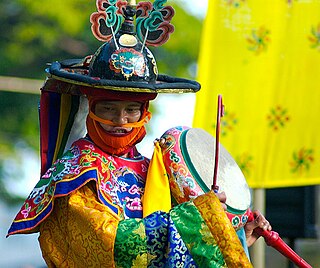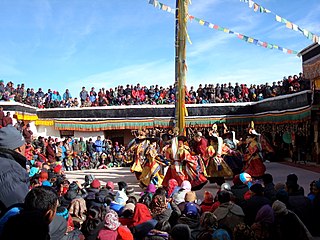
Ladakh is a region administered by India as a union territory and constitutes an eastern portion of the larger Kashmir region that has been the subject of a dispute between India and Pakistan since 1947 and India and China since 1959. Ladakh is bordered by the Tibet Autonomous Region to the east, the Indian state of Himachal Pradesh to the south, both the Indian-administered union territory of Jammu and Kashmir and the Pakistan-administered Gilgit-Baltistan to the west, and the southwest corner of Xinjiang across the Karakoram Pass in the far north. It extends from the Siachen Glacier in the Karakoram range to the north to the main Great Himalayas to the south. The eastern end, consisting of the uninhabited Aksai Chin plains, is claimed by the Indian Government as part of Ladakh, and has been under Chinese control.

Leh is a city in the Indian Union territory of Ladakh. It is the largest city and the joint capital of Ladakh. Leh, located in the Leh district, was also the historical capital of the Kingdom of Ladakh. The seat of the kingdom, Leh Palace, the former residence of the royal family of Ladakh, was built in the same style and about the same time as the Potala Palace in Tibet. Since they were both constructed in a similar style and at roughly the same time, the Potala Palace in Tibet and Leh Palace, the royal residence, are frequently contrasted. Leh is at an altitude of 3,524 m (11,562 ft), and is connected via National Highway 1 to Srinagar in the southwest and to Manali in the south via the Leh-Manali Highway.

Losar also known as Tibetan New Year, is a festival in Tibetan Buddhism. The holiday is celebrated on various dates depending on location tradition. The holiday is a new year's festival, celebrated on the first day of the lunisolar Tibetan calendar, which corresponds to a date in February or March in the Gregorian calendar. In 2024, the new year commenced on 10 February and celebrations ran until the 12th of the same month. It also commenced the Year of the Male Wood Dragon.

Buddha's Birthday or Buddha Day is a primarily Buddhist festival that is celebrated in most of South, Southeast and East Asia, commemorating the birth of the prince Siddhartha Gautama, who became the Gautama Buddha and founded Buddhism. According to Buddhist tradition and archaeologists, Gautama Buddha, c. 563-483 BCE, was born at Lumbini in Nepal. Buddha's mother was Queen Maya Devi, who delivered the Buddha while undertaking a journey to her native home, and his father was King Śuddhodana. The Mayadevi Temple, its gardens, and an Ashoka Pillar dating from 249 BCE mark the Buddha's birth place at Lumbini.

The cham dance is a lively masked and costumed dance associated with some sects of Tibetan Buddhism and Buddhist festivals. The dance is accompanied by music played by monks using traditional Tibetan musical instruments. The dances often offer moral instruction relating to karuṇā (compassion) for sentient beings and are held to bring merit to all who perceive them.

Alchi is a village in the Leh district of Ladakh, India. It is located in the Likir tehsil, on the banks of the Indus River 70 km downstream from the capital Leh. Unlike the other gompas in Ladakh, Alchi is situated on lowland, not on a hilltop.

Ladakh has a long history with evidence of human settlement from as back as 9000 b.c. It has been a crossroad of high Asia for thousands of years and has seen many cultures, empires and technologies born in its neighbours. As a result of these developments Ladakh has imported many traditions and culture from its neighbours and combining them all gave rise to a unique tradition and culture of its own.

Lamayuru or Yuru Monastery is a Tibetan Buddhist monastery in Lamayouro, Leh district, Ladakh, India. It is situated on the Srinagar-Leh highway 15 kilometres (9.3 mi) east of the Fotu La at a height of 3,510 metres (11,520 ft) and 19 km southwest of Khalsi.

Hemis Monastery is a Himalayan Buddhist monastery (gompa) of the Drukpa Lineage, in Hemis on the bank of Indus river, Ladakh, India. Situated 45 km from Leh, it was re-established in 1672 by the Ladakhi king Sengge Namgyal. The annual Hemis festival honouring Padmasambhava is held there in early June.

Thiksey Monastery or Thiksey Gompa is a Buddhist monastery affiliated with the Gelug school of Tibetan Buddhism. It is located on top of a hill in Thiksey approximately 19 kilometres (12 mi) east of Leh, in the Ladakh region of northern India. It is noted for its resemblance to the Potala Palace in Lhasa, Tibet, and is the largest monastery in central Ladakh, notably containing a separate set of buildings for female renunciates that has been the source of significant recent building and reorganization.

Likir Monastery or Likir Gompa (Klud-kyil) is a Buddhist monastery in Ladakh, Northern India. It is located at 3700m elevation, approximately 52 kilometres (32 mi) west of Leh. It is picturesquely situated on a little hill in the valley, in Likir village near the Indus River about 9.5 kilometres (5.9 mi) north of the Srinigar to Leh highway. It belongs to the Gelugpa sect of Tibetan Buddhism and was established in 1065 by Lama Duwang Chosje, at the command of the fifth king of Ladakh, Lhachen Gyalpo (Lha-chen-rgyal-po). It is off the Leh-Kargil Highway, 50 km west of Leh between Alchi & Basgo, 17 km west of Basgo Monastery & 21 km northeast of Alchi Monastery.

Diskit Monastery also known as Deskit Gompa or Diskit Gompa is the oldest and largest Buddhist monastery (gompa) in Diskit, Nubra Valley of the Leh district of Ladakh. It is 115 km north of Leh.

Phyang Monastery, Phyang Gompa is a Buddhist monastery located in Fiang village, just 15 or 16 kilometres west of Leh in Ladakh, northern India. It was established in 1515.

Matho Monastery, or Matho Gonpa or Mangtro Monastery or Mangtro Gonpa, from the Tibetan "mang" that means "many" and "tro" that means "happiness", is a Tibetan Buddhist monastery located 26 kilometres southeast of Leh in Ladakh, northern India, on the banks of the Indus River. The village of Matho is located at the mouth of a deep gorge running out of the Zanskar Range and across the Indus. It is directly opposite Thikse Monastery.

Shey Monastery or Gompa and the Shey Palace complex are structures located on a hillock in Shey, 15 kilometres (9.3 mi) to the south of Leh in Ladakh, northern India on the Leh-Manali road. Shey was the summer capital of Ladakh in the past. It contains a huge Shakyamuni Buddha statue. It is the second largest Buddha statue in Ladakh.

Alchi Monastery or Alchi Gompa is a Tibetan Buddhist monastery, known more as a monastic complex (chos-'khor) of temples in Alchi village in the Leh District, under the Ladakh Autonomous Hill Development Council of the Ladakh Union Territory. The complex comprises four separate settlements in the Alchi village in the lower Ladakh region with monuments dated to different periods. Of these four hamlets, Alchi monastery is said to be the oldest and most famous. It is administered by the Likir Monastery. It is 60 west of Leh on Leh-Kargil Highway.
All Ladakh Gonpa Association (ALGA) is the central organisation of the Buddhist monasteries in Ladakh, India. It aims to preserve and strengthen the monastic institutions. It was founded by the 19th Kushok Bakula Rinpoche in 1949 and he acted as its president for 41 years, from 1949 until 1991. In 1949, the first meeting of the great monasteries was held and ten monasteries took part. All Ladakh Gonpa Association was registered in 1959 and is run by a governing body consisting of fifteen lama members belonging to all four major schools of Tibetan Buddhism. There are sixteen major monastic institutions with hundreds of monks in each monastery.

Galdan Namchot is a festival celebrated in Tibet, Nepal, Mongolia and many regions of Himalaya, particularly in Ladakh, India. It is to commemorate the birth as well as parinirvana (death) and the Buddhahood of Je Tsongkhapa, a famous Scholar/teacher of Tibetan Buddhism whose activities led to the formation of the Gelug school of Tibetan Buddhism. Galdan Namchot also marks the beginning of the new year celebrations in Ladakh.

Gustor festival is celebrated in different monasteries of Ladakh. It is celebrated by various monasteries such as Thiksey, Spituk, Korzok and Karsha. The word Gustor དགུ་གཏོར / དགུ་སྟོར literally means 'Sacrifice of the 29th Day' in the Tibetan language. The festival is celebrated for two days, with different kinds of rituals, ceremonies, music & Cham Dance.

The culture of Ladakh refers to the traditional customs, belief systems, and political systems that are followed by Ladakhi people in India. The languages, religions, dance, music, architecture, food, and customs of the Ladakh region are similar to neighboring Tibet. Ladakhi is the traditional language of Ladakh. The popular dances in Ladakh include the khatok chenmo, cham, etc. The people of Ladakh also celebrate several festivals throughout the year, some of the most famous are Hemis Tsechu and Losar.
























